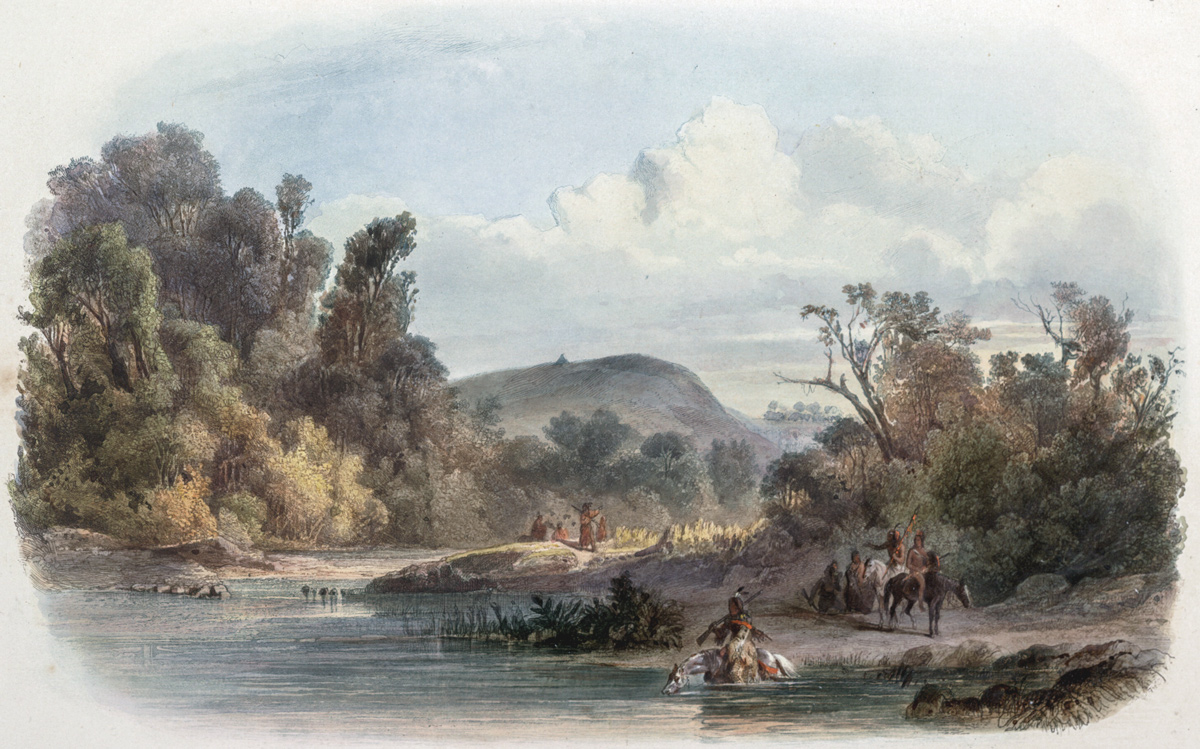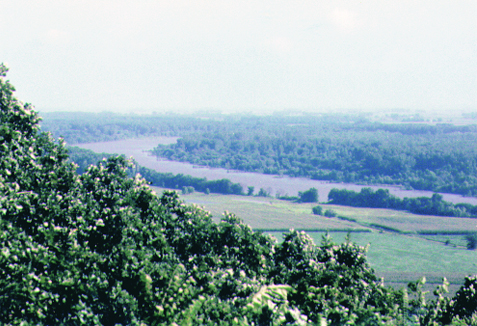The Omaha Nation
“Waschinga Sahba’s Grave on Blackbird’s Hill”[1]From Prince Maximilian of Wied-Neuwied, Travels in the Interior of North America, 1832-34 (London: Ackerman & Co, 1843), Vignette 10. A vignette is a borderless picture in which the image shades … Continue reading
Karl Bodmer (1809–1893)
Rare Book and Special Collections Division, Library of Congress.
Blackbird’s grave is the little pinnacle near the center of the picture, on the crest of the distant bluff.
In his paraphrase of the captains’ journals, Nicholas Biddle somewhat expanded Clark’s journal entry concerning the event that took place early on the morning of 11 August 1804. The boats came to at the foot of a hill on the west side of the Missouri River some eight miles northwest of Blue Lake, Iowa. The two captains and ten of the enlisted men climbed the hill to visit the grave of one of the most notorious and controversial leaders of the Omaha Nation, whose name was Washinga Sahba—Blackbird.
We halted on the south side for the purpose of examining a spot where one of the great chiefs of the Mahas [Omahas], named Blackbird, who died about four years ago [in 1800] of the smallpox, and was buried. A hill of yellow soft sandstone rises from the river in bluffs of various heights, till it ends in a knoll about 300 feet above the water; on the top of this a mound, of twelve feet diameter at the base and six feet high, is raised over the body of the deceased king; a pole of about eight feet high is fixed in the center, on which we placed a white flag, bordered with red, blue, and white. Blackbird seems to have been a personage of great consideration; for ever since his death he has been supplied with provisions, from time to time, by the superstitious regard of the Mahas.
The “mahar,” as Lewis and Clark called them, were the Omaha (U’mon’ha) Indians, who settled in present-day Nebraska sometime around 1700. They lived in earth lodges, hunted, and raised crops such as corn. Until struck by a smallpox epidemic in 1799-80, they were a secure and powerful force along the Missouri.
Their descendants now occupy the Omaha Reservation in northeast Nebraska, with headquarters in the town of Macy, just a mile or so west of the supposed site of Blackbird’s grave. The Omahas’ annual “Dance of Thanksgiving” is the oldest annual “powwow” in the United States.
The Omaha people of today insist the story that Blackbeard was buried sitting astride his horse, on a promontory from which his spirit could watch the river, is not true.[2]Alice C. Fletcher and Francis La Flesche, The Omaha Tribe, 2 vols. (Lincoln: University of Nebraska Press, 1972), 1:82-83. Blackbird had benefited from the friendship of white traders, and had gained power among his own people. He maintained that power by poisoning his enemies. Some say it was grateful traders who concocted the legend of his enshrinement.
Chief Blackbird’s Grave
On 18 December 1794, Jean Baptiste Truteau (b. 1748), who was employed by the Spanish-controlled Company of Explorers of the Upper Missouri to establish a trading post among the Mandans—although he never achieved that goal—met the notorious Omaha Indian chief, Waschinga Sahba, or Blackbird, and recorded his impressions:
This great chief of the Omahas was the most shrewd, the most deceitful and the greatest rascal of all the nations who inhabit the Missouri. He is feared and respected and is in great renown among all strange nations, none of whom dare to contradict him openly or to move against his wishes. . . . [H]e is a man who by his wit and cunning has raised himself to the highest place of authority in his nation and who has no parallel among all the savage nations of this continent. He is able to or cause to be done good or evil as it pleases him. It is not his war-like actions that have brought him so much power, for he has been inclined towards peace, but because of the fear that his men and his neighbors have of certain poisons which he uses, they say to kill off those who displease him.[3]A. P. Nasatir, Before Lewis and Clark: Documents Illustrating the History of the Missouri, 1785-1804, 2 vols., (Lincoln: University of Nebraska Press, 1990), 1: 282.
Blackbird’s reputation was well-known throughout the region in his own time, even though his power over his own people diminished abruptly when they discovered that the secret of his greatness lay in the arsenic he obtained from certain traders. Yet the legends continued to grow after his death. Lewis and Clark must have chosen to think well of the peace-loving chief, however, and considered the idea of paying their respects by leaving a token of their respect on his grave as an obligatory—and serviceably conspicuous—diplomatic gesture. They must have planned it in St. Louis, and had the one-of-a-kind flag made there, although there is no mention of it at all in the expedition’s journals or correspondence.
The white flag would have symbolized the promise of peace the captains hoped to extract from the Omahas’ headmen when they met them (which never happened); the red and blue borders would been a link to the national colors they would present to the Omahas’ chief (whom they never saw). The captains could have spun a good tale out of all those correspondences that surely would have won the hearts of the Omahas, but they never got the chance. The only Omahas they met were a few women and boys who were among 48 prisoners the Lakota Sioux had captured in a recent battle.
View from Blackbird Hill
In 1804 the Missouri River flowed along the foot of the bluff; today its bed lies a half mile or more to the east of this point. In the absence of periodic wildfires during nearly all of the 20th century, dense timber and undergrowth have made the river’s wide-ranging meanders impossible to see from Blackbird’s hill, and also made the site of the chief’s grave invisible from the river.
Henry Marie Brackenridge (1786-1871), in his journal of his voyage to the Mandan villages in 1811, passed the place, “one of the curiosities of the Missouri,” in May of 1811. He remarked that beginning above the landmark hill, the Missouri began
a strange winding course, several times returning upon its steps; and at length coming within nine hundred yards of where it is first approached; so that in a course of thirty miles the Black-bird hill is still near us.[4]Henry Marie Brackenridge, Views of Louisiana, Together with a Journal of a Voyage up the Missouri River, in 1811, 1814; reprint (Chicago: Quadrangle Books, 1962), 229. Brackenridge briefly recounted … Continue reading
By 1832, when Prince Maximilian and Karl Bodmer reached this point, the river had cut off that complex meander.
Blackbird Hill is a High Potential Historic Site along the Lewis and Clark National Historic Trail managed by the U.S. National Park Service. The site is on private property but can be viewed from adjacent roads.—ed.
Related Pages
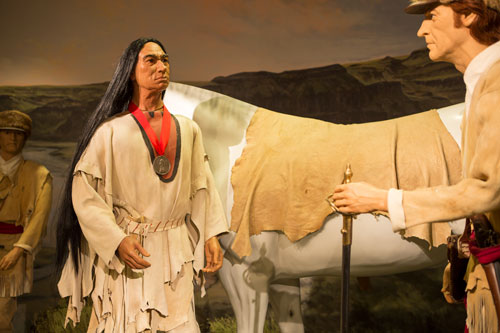
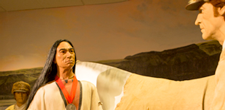
The expedition left horse tracks of at least four to five hundred miles on a westward lineal course, plus at least a thousand miles easterly, widely scattered over strikingly varied terrain. The Corps of Discovery had become, in effect, a kind of cavalry unit.
August 10, 1804
Blackbird Hill in view
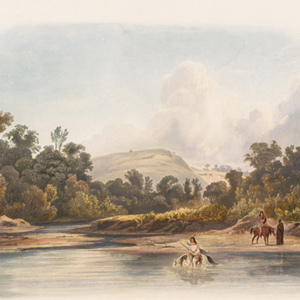

The boats sail 22½ miles up the Missouri River, and they encamp within view of Blackbird Hill. Lewis collects the earliest plant specimen that survives today, field horsetail.
August 11, 1804
Honoring Blackbird
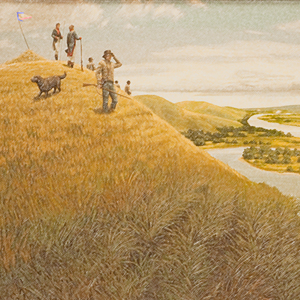

The captains place a flag at the grave of Blackbird, an Omaha chief and prolific trader. They then continue up the Missouri River passing a creek where many Omaha people died from smallpox.
Notes
| ↑1 | From Prince Maximilian of Wied-Neuwied, Travels in the Interior of North America, 1832-34 (London: Ackerman & Co, 1843), Vignette 10. A vignette is a borderless picture in which the image shades off irregularly into the color of the paper. |
|---|---|
| ↑2 | Alice C. Fletcher and Francis La Flesche, The Omaha Tribe, 2 vols. (Lincoln: University of Nebraska Press, 1972), 1:82-83. |
| ↑3 | A. P. Nasatir, Before Lewis and Clark: Documents Illustrating the History of the Missouri, 1785-1804, 2 vols., (Lincoln: University of Nebraska Press, 1990), 1: 282. |
| ↑4 | Henry Marie Brackenridge, Views of Louisiana, Together with a Journal of a Voyage up the Missouri River, in 1811, 1814; reprint (Chicago: Quadrangle Books, 1962), 229. Brackenridge briefly recounted the story of the celebrated chief, ending it with the cynical, racist observation that it proved “ignorant and savage man can only be ruled through the means of fear.” |
Experience the Lewis and Clark Trail
The Lewis and Clark Trail Experience—our sister site at lewisandclark.travel—connects the world to people and places on the Lewis and Clark Trail.
Discover More
- The Lewis and Clark Expedition: Day by Day by Gary E. Moulton (University of Nebraska Press, 2018). The story in prose, 14 May 1804–23 September 1806.
- The Lewis and Clark Journals: An American Epic of Discovery (abridged) by Gary E. Moulton (University of Nebraska Press, 2003). Selected journal excerpts, 14 May 1804–23 September 1806.
- The Lewis and Clark Journals. by Gary E. Moulton (University of Nebraska Press, 1983–2001). The complete story in 13 volumes.
